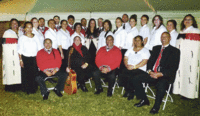Phil Cody sm
3 May 2012
N

Nga Karere Choir
Maori cultural clubs from around the country have been gathering for the hui at Easter since the first one held at Otaki in 1946 and this year about 1500 mostly young people in 10 North Island clubs converged on Opononi.
The Whangarei-based Te Rōpū o Te Whetu hosted the Hui Aranga – The Gathering of the Resurrection – a combined cultural and faith experience involving kapa haka, sport, prayer, kai and time together in competition and catching up on family.
‘This is an important gathering for Māori and Marists,’ said Phil Cody. ‘Following the early Marists and their mission, the annual hui is a terrific place to build relationships.’
The cradle of Catholicism
The spiritual director for Te Waiora Catholic group in Palmerston North, Danny Karatea-Goddard, said Northland is well known among Katorika (Catholics) as the cradle of Catholicism with waiata featuring Bishop Pompallier, the first bishop to New Zealand who, with his Marist companions, ministered among many Maori in the 19th century including in Tai Tokerau.
‘Many of the kapa haka compositions had a Tai Tokerau theme,’ he said.
The atmosphere of the Hokianga was very evident, right down to tasting the local mullet fish delicacy.There is a lovely spirit in the place, despite the fierce competition. One of the midgets asked me after they won the Touch rugby final, ‘Did you pray for us, Pa?’ Phil Cody said.
Pompallier’s remains are kept in a crypt at Motuti where they are honoured by Pa Henare Tate and the local people.
Ngā Karere won various trophies from Mokopuna Touch, Men’s Sacred Solo, Mokopuna religious quiz, senior men’s tennis to junior women’s whaikōrero (oratory).
These trophies or taonga (treasures) take on a personal nature and are generally dedicated to ancestors. In a sense the ancestors live on in these cups and shields and remind the winners and clubs of the purpose of the Hui Aranga, namely to live out today the love and selflessness portrayed for us in Jesus Christ.
A Central Council coordinates the 10 or so clubs which centre mainly on the Whanganui River, (Ohakune or Ruapehu to St Vincent’s and St Peter Chanel) and then across to Taranaki and back to a strong presence at Tauranga and up to Hawke’s Bay.
In 2013 the Hui Aranga will be hosted by Te Araukuku of Taranaki at Hawera. The following year the Hui Aranga returns to Wellington.
The weekend consisted in various gatherings under canvas to celebrate the death and resurrection of Christ. At times the clubs would dress up especially for a religious procession or karakia. Then the many participants put on traditional costume for the waiata, poi, haka and combined action songs, all of which go towards an overall mark for the hui.
Nepia Takuira-Mita of Nga Karere won the senior men’s sacred solo with a lively reggae number commenting on the hui –
Hui Aranga, Hui Aranga, kia kaha, kia toa
(Easter Gathering, Hui Aranga, be strong, be brave)
Hui Aranga, Hui Aranga, te whānau kotahi mō te katoa.
(Easter Gathering, Hui Aranga, you form one family for us all)
This Hui Aranga report was first published on http://cathnews.co.nz April 13, 2012 and was printed in the May edition of welcom
Image: Nga Karere Choir, taken by Sarah Goodwin